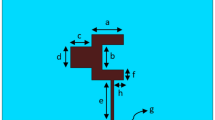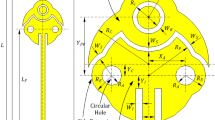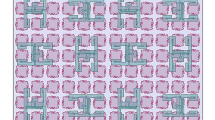Abstract
Design of 5G and beyond 5G telecommunication systems relies on utilization of diverse solutions for different envisioned applications and different constituents of an entire system. One of the research directions is the utilization of a global unlicensed millimeter wave frequency band from 57 to 66 GHz for the high throughput data transfer. Apart from the wide spectrum availability at 60 GHz, there are many problems to be resolved before the concept can become fully functional; one of the requirements is the design of low-cost, energy efficient, wideband antennas with enhanced gain, capable of overcoming propagation losses at 60 GHz. We investigate the benefits and shortcomings of four types of low-cost, printed antennas as the constituents of sub-array elements for the large line-of-sight MIMO arrays. The results are put into perspective by comparison with the most used low-cost microstrip patch sub-array element. The state-of-the-art method-of-moments computations were employed in the highly accurate analyses of the four compared antenna array elements. Although the gains of such sub-arrays can be boosted by the increases in antenna numbers, this does not hold for the efficiency or bandwidth of operation; therefore, radiation patterns and characteristics at the level of individual antennas cannot be ignored as these translate directly into the behavior of an array. Careful choice of antenna type and initial efforts in the sub-array design should be seen as a necessary first step in the design of a large line-of-sight MIMO array of superior characteristics.
Graphic Abstract








Similar content being viewed by others
References
Shafi, M., Molisch, A. F., Smith, P. J., Haustein, T., Zhu, P., De Silva, P., et al. (2017). 5G: A tutorial overview of standards, trials, challenges, deployment, and practice. IEEE Journal on Selected Areas in Communications,35(6), 1201–1221. https://doi.org/10.1109/JSAC.2017.2692307.
Chávez-Santiago, R., Szydełko, M., Kliks, A., Foukalas, F., Haddad, Y., Nolan, K. E., et al. (2015). 5G: The convergence of wireless communications. Wireless Personal Communications,83(3), 1617–1642. https://doi.org/10.1007/s11277-015-2467-2.
Panwar, N., Sharma, S., & Singh, A. K. (2016). A survey on 5G: The next generation of mobile communication. Physical Communication,18(2), 64–84. https://doi.org/10.1016/j.phycom.2015.10.006.
Gavrilovska, L., Rakovic, V., & Atanasovski, V. (2016). Visions towards 5G: Technical requirements and potential enablers. Wireless Personal Communications,87(3), 731–757. https://doi.org/10.1007/s11277-015-2632-7.
Badoi, C. I., Prasad, N., Croitoru, V., & Prasad, R. (2011). 5G based on cognitive radio. Wireless Personal Communications,57(3), 441–464. https://doi.org/10.1007/s11277-010-0082-9.
Hawasli, M., & Çolak, S. A. (2017). Toward green 5G heterogeneous small-cell networks: Power optimization using load balancing technique. AEU-International Journal of Electronics and Communications,82, 474–485. https://doi.org/10.1016/j.aeue.2017.09.012.
Gutiérrez, J., Maletic, N., Camps-Mur, D., García, E., Berberana, I., Anastasopoulos, M., et al. (2016). 5G-XHaul: A converged optical and wireless solution for 5G transport networks. Transactions on Emerging Telecommunications Technologies,27(9), 1187–1195. https://doi.org/10.1002/ett.3063.
Puglielli, A., Townley, A., LaCaille, G., Milovanović, V., Lu, P., Trotskovsky, K., et al. (2016). Design of energy- and cost-efficient massive MIMO arrays. Proceedings of the IEEE,104(3), 586–606. https://doi.org/10.1109/JPROC.2015.2492539.
Bai, Q., & Nossek, J. A. (2015). Energy efficiency maximization for 5G multi-antenna receivers. Transactions on Emerging Telecommunications Technologies,26(1), 3–14. https://doi.org/10.1002/ett.2892.
Yazdan, A., Park, J., Park, S., Khan, T. A., & Heath, R. W. (2017). Energy-efficient massive MIMO: Wireless-powered communication, multiuser MIMO with hybrid precoding, and cloud radio access network with variable-resolution ADCs. IEEE Microwave Magazine,18(5), 18–30. https://doi.org/10.1109/MMM.2017.2691422.
Gao, Y., Ma, R., Wang, Y., Zhang, Q., & Parini, C. (2016). Stacked patch antenna with dual-polarization and low mutual coupling for massive MIMO. IEEE Transactions on Antennas and Propagation,64(10), 4544–4549. https://doi.org/10.1109/tap.2016.2593869.
Harris, P., Malkowsky, S., Vieira, J., Bengtsson, E., Tufvesson, F., Hasan, W. B., et al. (2017). Performance characterization of a real-time massive MIMO system with LOS mobile channels. IEEE Journal on Selected Areas in Communications,35(6), 1244–1253. https://doi.org/10.1109/JSAC.2017.2686678.
Elwi, T. A. (2018). A miniaturized folded antenna array for MIMO applications. Wireless Personal Communications,98(2), 1871–1883. https://doi.org/10.1007/s11277-017-4950-4.
Abdalla, M. A., & Ibrahim, A. A. (2017). Design and performance evaluation of metamaterial inspired MIMO antennas for wireless applications. Wireless Personal Communications,95(2), 1001–1017. https://doi.org/10.1007/s11277-016-3809-4.
Haroon, S., Alimgeer, K. S., Khalid, N., Malik, B. T., Shafique, M. F., & Khan, S. A. (2015). A low profile UWB antenna with triple band suppression characteristics. Wireless Personal Communications,82(1), 495–507. https://doi.org/10.1007/s11277-014-2237-6.
Swindlehurst, A. L., Ayanoglu, E., Heydari, P., & Capolino, F. (2014). Millimeter-wave massive MIMO: The next wireless revolution? IEEE Communications Magazine,52(9), 56–62. https://doi.org/10.1109/MCOM.2014.6894453.
Elsharkawy, R. R., Hindy, M., Saleeb, A. A., & El-Rabaie, E.-S. M. (2017). A reflectarray with octagonal unit cells for 5-G applications. Wireless Personal Communications,97(2), 2999–3016. https://doi.org/10.1007/s11277-017-4657-6.
Ramesh, S., & Rao, T. R. (2015). Planar high gain dielectric loaded exponentially tapered slot antenna for millimeter wave wireless communications. Wireless Personal Communications,84(4), 3179–3192. https://doi.org/10.1007/s11277-015-2795-2.
Rabbani, M. S., & Ghafouri-Shira, H. (2017). Evaluation of gain enhancement in improved size microstrip antenna arrays for millimetre-wave applications. AEU-International Journal of Electronics and Communications,81, 105–113. https://doi.org/10.1016/j.aeue.2017.07.017.
Daniels, R. C., & Heath, R. W. (2007). 60 GHz wireless communications: emerging requirements and design recommendations. IEEE Vehicular Technology Magazine,2(3), 41–50. https://doi.org/10.1109/MVT.2008.915320.
Reggiani, L., Baccetti, B., & Dossi, L. (2014). The role of adaptivity in MIMO line-of-sight systems for high capacity backhauling. Wireless Personal Communications,74(2), 373–389. https://doi.org/10.1007/s11277-013-1290-x.
Rappaport, T. S., MacCartney, G. R., Samimi, M. K., & Sun, S. (2015). Wideband millimeter-wave propagation measurements and channel models for future wireless communication system design. IEEE Transactions on Communications,63(9), 3029–3056. https://doi.org/10.1109/TCOMM.2015.2434384.
Sakarellos, V. K., Kourogiorgas, C. I., Skraparlis, D., Panagopoulos, A. D., & Kanellopoulos, J. D. (2013). End-to-end performance analysis of millimeter wave triple-hop backhaul transmission systems. Wireless Personal Communications,71(4), 2725–2740. https://doi.org/10.1007/s11277-012-0967-x.
Rangan, S., Rappaport, T. S., & Erkip, E. (2014). Millimeter-wave cellular wireless networks: potentials and challenges. Proceedings of the IEEE,102(3), 366–385. https://doi.org/10.1109/JPROC.2014.2299397.
Biglarbegian, B., Fakharzadeh, M., Busuioc, D., Nezhad-Ahmadi, M., & Safavi-Naeini, S. (2011). Optimized microstrip antenna arrays for emerging millimeter-wave wireless applications. IEEE Transactions on Antennas and Propagation,59(5), 1742–1747. https://doi.org/10.1109/TAP.2011.2123058.
Driessen, P. F., & Foschini, G. J. (1999). On the capacity formula for multiple input–multiple output wireless channels: a geometric interpretation. IEEE Transactions on Communications,47(2), 173–176. https://doi.org/10.1109/26.752119.
Gesbert, D., Bolcskei, H., Gore, D. A., & Paulraj, A. J. (2002). Outdoor MIMO wireless channels: models and performance prediction. IEEE Transactions on Communications,50(12), 1926–1934. https://doi.org/10.1109/TCOMM.2002.806555.
Torkildson, E., Madhow, U., & Rodwell, M. (2011). Indoor millimeter wave MIMO: feasibility and performance. IEEE Transactions on Wireless Communications,10(12), 4150–4160. https://doi.org/10.1109/TWC.2011.092911.101843.
Irish, A. T., Quitin, F., Madhow, U. & Rodwell, M. (2013). Achieving multiple degrees of freedom in long-range mm-wave MIMO channels using randomly distributed relays. In Proceedings Asilomar conference on signals, systems and computers (pp. 722–727), Pacific Grove, CA. https://doi.org/10.1109/acssc.2013.6810378
Kildal, P., Rosengren, K., Byun, J., & Lee, J. (2002). Definition of effective diversity gain and how to measure it in a reverberation chamber. Microwave and Optical Technology Letters,34(1), 56–59. https://doi.org/10.1002/mop.10372.
Nabar, R. U., Bolcskei, H., Erceg, V., Gesbert, D., & Paulraj, A. J. (2002). Performance of multiantenna signaling techniques in the presence of polarization diversity. IEEE Transactions on Signal Processing,50(10), 2553–2562. https://doi.org/10.1109/TSP.2002.803322.
Jiang, J. S., & Ingram, M. A. (2005). Spherical-wave model for short-range MIMO. IEEE Transactions on Communications,53(9), 1534–1541. https://doi.org/10.1109/TCOMM.2005.852842.
Bøhagen, F., Orten, P., & Øien, G. E. (2007). Design of optimal high-rank line-of-sight MIMO channels. IEEE Transactions on Wireless Communications,6(4), 1420–1425. https://doi.org/10.1109/TWC.2007.348338.
Neil, C. T., Garcia-Rodriguez, A., Smith, P. J., Dmochowski, P. A., Masouros, C., & Shafi, M. (2018). On the performance of spatially correlated large antenna arrays for millimeter-wave frequencies. IEEE Transactions on Antennas and Propagation,66(1), 132–148. https://doi.org/10.1109/TAP.2017.2759842.
Dadgarpour, A., Sharifi Sorkherizi, M., & Kishk, A. A. (2016). Wideband low-loss magnetoelectric dipole antenna for 5G wireless network with gain enhancement using meta lens and gap waveguide technology feeding. IEEE Transactions on Antennas and Propagation,64(12), 5094–5101. https://doi.org/10.1109/TAP.2016.2620522.
Wang, L., Guo, Y., & Sheng, W. (2013). Wideband high-gain 60-GHz LTCC L-probe patch antenna array with a soft surface. IEEE Transactions on Antennas and Propagation,61(4), 1802–1809. https://doi.org/10.1109/TAP.2012.2220331.
Tseng, C., Chen, C., & Chu, T. (2008). A low-cost 60-GHz switched-beam patch antenna array with Butler matrix network. IEEE Antennas and Wireless Propagation Letters,7, 432–435. https://doi.org/10.1109/LAWP.2008.2001849.
Skrivervik, A. K., Zürcher, J. F., Staub, O., & Mosig, J. R. (2001). PCS antenna design: The challenge of miniaturization. IEEE Antennas and Propagation Magazine,43(4), 12–27. https://doi.org/10.1109/74.951556.
Low, Z. N., Cheong, J. H., & Law, C. L. (2005). Low-cost PCB antenna for UWB applications. IEEE Antennas and Wireless Propagation Letters,4, 237–239. https://doi.org/10.1109/LAWP.2005.852577.
Akkermans, J. A. G., van Dijk, R. & Herben M. H. A. J. (2007). Millimeter-wave antenna measurement. In Proceedings of European microwave conference (pp. 83–86), Munich, Germany. https://doi.org/10.1109/eumc.2007.4405131
Zhang, Y. P., & Liu, D. (2009). Antenna-on-Chip and Antenna-in-Package solutions to highly integrated millimeter-wave devices for wireless communications. IEEE Transactions on Antennas and Propagation,57(10), 2830–2841. https://doi.org/10.1109/TAP.2009.2029295.
Al-Alem, Y., & Kishk, A. A. (2018). Low-profile low-cost high gain 60 GHz antenna. IEEE Access,6(3), 13376–13384. https://doi.org/10.1109/ACCESS.2018.2815082.
Kolundzija, B. & Djordjevic, A. (2002). Electromagnetic modeling of composite metallic and dielectric structures. Norwood, MA: Artech House. WIPL-D 2013 WIPL-D Pro v11.0. Retrieved December 12, 2019, from http://www.wipl-d.com/.
Kolundzija, B., & Sumic, D. (2008). Electromagnetic simulation of complex and electrically large structures in WIPL-D Pro. IEEE Microwave Magazine,9(6), 159–162. https://doi.org/10.1109/MMM.2008.929694.
Kolundzija, B., Petrovic, V., Djordjevic, A. & Sarkar, T. (2000). Efficient method of moment analysis based on imaging and edging. In IEEE antennas and propagation society international symposium. transmitting waves of progress to the next millennium. In conjunction with: USNC/URSI National Radio Science Meeting (Vol. 4, pp. 2298–2301), Salt Lake City, UT. https://doi.org/10.1109/aps.2000.874953
Klopf, E. M., Sekeljic, N. J., Ilic, M. M., & Notaros, B. M. (2012). Optimal modeling parameters for higher order MoM-SIE and FEM-MoM electromagnetic simulations. IEEE Transactions on Antennas and Propagation,60(6), 2790–2801. https://doi.org/10.1109/TAP.2012.2194669.
Yaghjian, A. D., & Best, S. R. (2005). Impedance, bandwidth, and Q of antennas. IEEE Transactions on Antennas and Propagation,53(4), 1298–1324. https://doi.org/10.1109/TAP.2005.844443.
Savić, S. V. & Kolundžija, B. M. (2013). Efficient iterative algorithm for design of probe fed rectangular microstrip patch antennas using software for electromagnetic modeling. In Proceedings of 29th annual review of progress in applied computational electromagnetics, ACES 2013 (pp. 789–793), Monterey, California, USA.
Shackelford, A. K., Lee, K. F., & Luk, K. M. (2003). Design of small-size wide-bandwidth microstrip-patch antennas. IEEE Antennas and Propagation Magazine,45(1), 75–83. https://doi.org/10.1109/MAP.2003.1189652.
Deal, W.R., Qian, Y., Itoh, T. & Radisic, V. (1999). Planar integrated antenna technology. Microwave Journal. http://www.microwavejournal.com/articles/2677-planar-integrated-antenna-technology.
Kim, D., & Yeo, J. (2010). A passive RFID tag antenna installed in a recessed cavity in a metallic platform. IEEE Transactions on Antennas and Propagation,58(12), 3814–3820. https://doi.org/10.1109/TAP.2010.2078438.
Zhang, J., Yang, H. C., & Yang, D. (2012). Design of a new high-gain circularly polarized antenna for Inmarsat communications. IEEE Antennas and Wireless Propagation Letters,11, 350–353. https://doi.org/10.1109/LAWP.2012.2191382.
Zhong, Y., Yang, G., & Zhong, L. (2015). Gain enhancement of bow-tie antenna using fractal wideband artificial magnetic conductor ground. Electronics Letters,51(4), 315–317. https://doi.org/10.1049/el.2014.4017.
Stutzman, W. L. (1998). Estimating directivity and gain of antennas. IEEE Antennas and Propagation Magazine,40(4), 7–11. https://doi.org/10.1109/74.730532.
Gustafson, C., Haneda, K., Wyne, S., & Tufvesson, F. (2014). On mm-wave multipath clustering and channel modeling. IEEE Transactions on Antennas and Propagation,62(3), 1445–1455. https://doi.org/10.1109/TAP.2013.2295836.
Jafari, A., Mavridis, T., Petrillo, L., Sarrazin, J., Peter, M., Keusgen, W., et al. (2016). UWB interferometry TDOA estimation for 60-GHz OFDM communication systems. IEEE Antennas and Wireless Propagation Letters,15, 1438–1441. https://doi.org/10.1109/LAWP.2015.2512327.
Balanis, C. A. (1997). Antenna theory: Analysis and design (2nd ed.). New York, NY: Wiley.
Guraliuc, A. R., Zhadobov, M., Sauleau, R., Marnat, L., & Dussopt, L. (2017). Near-field user exposure in forthcoming 5G scenarios in the 60 GHz band. IEEE Transactions on Antennas and Propagation,65(12), 6606–6615. https://doi.org/10.1109/TAP.2017.2754473.
Björnson, E., Sanguinetti, L., Hoydis, J., & Debbah, M. (2015). Optimal design of energy-efficient multi-user MIMO systems: Is massive MIMO the answer? IEEE Transactions on Wireless Communications,14(6), 3059–3075. https://doi.org/10.1109/TWC.2015.2400437.
Buzzi, S., Chin-Lin, I., Klein, T. E., Poor, H. V., Yang, C., & Zappone, A. (2016). A survey of energy-efficient techniques for 5G networks and challenges ahead. IEEE Journal on Selected Areas in Communications,34(4), 697–709. https://doi.org/10.1109/jsac.2016.2550338.
Acknowledgements
This work was supported by the Serbian Ministry of Education, Science, and Technological Development (MPNTR) under projects TR-32005 and III-45003, and by the project of bilateral cooperation Germany-Serbia “Development of robust and efficient LOS-MIMO antenna arrays, adaptive beamforming algorithms, and high performance signal processing for 5G multigigabit broadband wireless communications”, funded jointly by MPNTR (Serbia) and DAAD (Germany). (Project acronym: 5G-MIMO-Array).
Author information
Authors and Affiliations
Corresponding author
Ethics declarations
Conflict of interest
The authors declare that they have no conflict of interest.
Additional information
Publisher's Note
Springer Nature remains neutral with regard to jurisdictional claims in published maps and institutional affiliations.
Rights and permissions
About this article
Cite this article
Vojnović, N.M., Savić, S.V., Ilić, M.M. et al. Performance Analysis of Low-Cost Printed Antenna Array Elements for 5G LOS-MIMO Arrays at 60 GHz. Wireless Pers Commun 111, 2641–2658 (2020). https://doi.org/10.1007/s11277-019-07007-4
Published:
Issue Date:
DOI: https://doi.org/10.1007/s11277-019-07007-4




